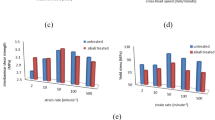Abstract
This research work was concerned with the evaluation of the effect of fibre content on the mechanical properties of composites. Composites were fabricated using jute/phenol formaldehyde (PF), rockwool/PF, and jute/rockwool hybrid PF with varying fibre loadings. Jute and rockwool fibre reinforced PF composites were fabricated with varying fibre loadings (16, 25, 34, 42, 50, and 60 vol.%). The jute/rockwool hybrid PF composites were manufactured at various ratios of jute/rockwool fibres such as 1:0, 0.92:0.08, 0.82:0.18, 0.70:0.30, 0.54:0.46, 0.28:0.72, and 0:1. Total fibre content of the hybrid composites was 42 vol.%. The results showed that tensile strength of the composite increased with increasing fibre content up to 42 vol.% over which it decreased for jute and rockwool fibre reinforced PF composites. Flexural strength of the composite was noted to peak at a fibre loading of 42 vol.% for jute/PF composites, and 34 vol.% for rockwool/PF composites. Impact strength of jute/PF composites increased with increasing fibre loading but that of rockwool/PF composites decreased at higher (>34 vol.%) fibre loadings. Tensile, flexural, and impact strengths of jute/PF composites were found to be higher than those of rockwool/PF composites. The maximum hardness values were obtained 42 vol.% for jute/PF composite, and 34 vol.% for rockwool/PF composite. Further increase in fibre loading adversely affected the hardness of both composites. For jute/rockwool hybrid PF composites, tensile and impact strengths decreased with increasing rockwool fibre loading. The maximum flexural strength of jute/rockwool hybrid PF composites was obtained at a 0.82:0.18 jute/rockwool fibre ratio while maximum hardness was observed at a 0.28:0.72 jute/rockwool fibre ratio. The fractured surfaces of the composites were analysed using scanning electron microscope in order to have an insight into the failure mechanism and fibre/matrix interface adhesion.
Similar content being viewed by others
References
T. M. Gowda, A. C. B. Naidu, and R. Chhaya, Compos. A, 30, 277 (1999).
A. S. Singha and V. K. Thakur, Polym-Plast. Technol. Eng., 48, 48 (2009).
G. S. Chauhan, I. Kaur, B. N. Misra, A. S. Singha, and B. S. Kaith, Polym. Degrad. Stab., 69, 261 (2000).
T. Yuanjian and D. H. Isaac, Compos. Sci. Technol., 67, 3300 (2007).
J. Maya, F. Bejoy, T. Sabu, and K. T. Varughese, Polym. Compos., 27, 671 (2006).
A. N. Nakagiato and H. Yano, Appl. Phys. Mater., 78, 547 (2004).
Y. Li, Y. W. Mai, and L. Ye, Compos. Sci. Technol., 60, 2037 (2000).
L. A. Pothen, S. Thomas, and N. R. Neelakandan, J. Reinf. Plast. Compos., 16, 744 (1997).
L. Y. Mwaaikambo and M. Ansell, J. Appl. Polym. Sci., 272, 108 (1999).
H. D. Rozman, R. N. Kumar, M. R. M. Adlli, and H. A. Abusama, J. Wood. Chem. Technol., 18, 471 (1998).
D. De, B. Adhikari, and D. De, Polym. Adv. Technol., 18, 72 (2007).
R. Velmurugan and V. Manikandan, Compos. A, 38, 2216 (2007).
A. N. Shah and S. C. Lakkad, Fibre. Sci. Technol., 15, 41 (1981).
Catalog, Rockwool, Izocam Ltd., Gebze, Turkey.
Q. Mu, C. Wei, and S. Feng, Polym. Compos., 30, 131 (2009).
B. Singh, M. Gupta, and A. Verma, Compos. Sci. Technol., 60, 581 (2000).
S. Mishra, A. K. Mohanty, L. T. Drzal, M. Misra, S. Parija, S. K. Nayak, and S. S. Tripaty, Compos. Sci. Technol., 63, 1377 (2003).
M. S. Sreekala, J. George, M. G. Kumaran, and S. Thomas, Compos. Sci. Technol., 62, 339 (2002).
Catalog, Cukurova Kimya Ltd., Manisa, Turkey.
Md. R. Rahman, Md. M. Huque, Md. N. Islam, and M. Hasan, Compos. A, 39, 1739 (2008).
P. Wambua, J. Ivens, and I. Verpoest, Compos. Sci. Technol., 63, 1259 (2003).
M. Jacob, S. Thomas, and K. T. Varughese, Compos. Sci. Technol., 64, 955 (2004).
S. Joseph, M. S. Sreekala, Z. Oommen, P. Koshy, and S. Thomas, Compos. Sci. Technol., 62, 1857 (2002).
S. Joseph, M. S. Sreekala, P. Koshy, and S. Thomas, J. Appl. Polym. Sci., 109, 1439 (2008).
J. K. Wells and P. W. Beaumont, J. Mater. Sci., 20, 1275 (1985).
J. L. Thomason and M. A. Vlug, Compos. A, 28, 277 (1997).
Author information
Authors and Affiliations
Corresponding author
Rights and permissions
About this article
Cite this article
Öztürk, B. Hybrid effect in the mechanical properties of jute/rockwool hybrid fibres reinforced phenol formaldehyde composites. Fibers Polym 11, 464–473 (2010). https://doi.org/10.1007/s12221-010-0464-3
Received:
Revised:
Accepted:
Published:
Issue Date:
DOI: https://doi.org/10.1007/s12221-010-0464-3




